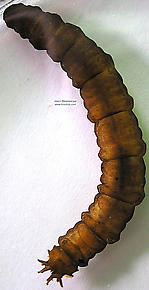Blog & Latest Updates
Fly Fishing Articles
Insects by Common Name


True Fly Family Tipulidae (Crane Flies)
Taxonomic Navigation -?-
Kingdom
Animalia (Animals)
» Phylum
Arthropoda (Arthropods)
» Class
Insecta (Insects)
» Order
Diptera (True Flies)
» Family Tipulidae (Crane Flies)
5 genera aren't included.
Common Name
| Match | Common Name |
| Crane Flies |
Hatching Behavior
Craneflies pupate for one to three weeks. The species which do so in the water then swim to the surface to emerge in the style of caddisflies, and are presumably vulnerable to trout, though I have not read about good fishing during these events.
Swisher and Richards in Selective Trout say the larvae all crawl out of the water to pupate, conflicting with the above account. There are so many species that it seems likely both behaviors occur in some species.
Egg-Laying Behavior
Adult craneflies are occasionally important during their mating flights when their clumsy flying can crash them by accident into the water. Windy days may also blow them in.
Larva & Pupa Biology
Diet: Mostly vegetation
Many cranefly species live in many different underwater habitats, and others live in moist soil nowhere near the dirt. We anglers are only concerned with the former.They live as larvae for about a year and sometimes the larvae end up in the drift in good enough numbers to get the trout excited. Buggy grub-like flies are locally known to perform well on certain rivers, and this may be due to a good population of drifting cranefly larvae (or perhaps I speculate too far). In general, larvae are more likely to be important than the adults.
Ernest Schwiebert notes in Matching the Hatch that they are most common in trout stomachs after the water has been high.
Pictures of 11 Crane Fly Specimens:
Tipulidae (Crane Flies) Crane Fly Adult View 15 Pictures
View 15 Pictures
 View 15 Pictures
View 15 PicturesCollected May 29, 2007 from Brodhead Creek in Pennsylvania
Added to Troutnut.com by Troutnut on June 4, 2007
Added to Troutnut.com by Troutnut on June 4, 2007
Tipulidae (Crane Flies) Crane Fly Larva View 4 Pictures
View 4 Pictures
 View 4 Pictures
View 4 PicturesCollected January 14, 2004 from unknown in Wisconsin
Added to Troutnut.com by Troutnut on January 25, 2006
Added to Troutnut.com by Troutnut on January 25, 2006
Tipulidae (Crane Flies) Crane Fly Larva View 3 Pictures
View 3 Pictures
 View 3 Pictures
View 3 PicturesCollected January 13, 2004 from the Namekagon River in Wisconsin
Added to Troutnut.com by Troutnut on January 25, 2006
Added to Troutnut.com by Troutnut on January 25, 2006
Your Thoughts On Tipulidae:
Top 10 Fly Hatches
Top Gift Shop Designs
Eat mayflies.
Top Insect Specimens
Miscellaneous Sites
Troutnut.com is copyright © 2004-2024 Jason
Neuswanger (email Jason). See my FAQ for information about use of my images.
 privacy policy
privacy policy
